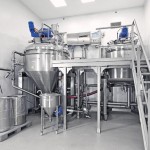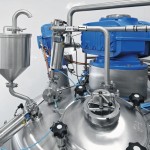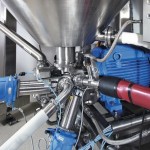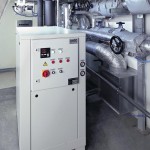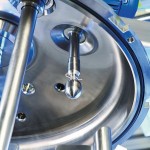Maximum flexibility in the production of creams, ointments and gels was the key factor behind Qualiphar-Gifrers decision to invest in a new plant. The BG 2000 batch vacuum processing plant from Zoatec satisfies this requirement and is suitable for producing between 400 and 2000 l batches of emulsions and suspensions.
The Author: Walter Sonntag Division Manager Marketing/Documentation AZO
The Belgian-French pharmaceuticals manufacturer Qualiphar-Gifrer employs a total of 430 staff at two production sites: Qualiphar in Bornem (Belgium) and Gifrer in Lyon (France). The company was founded in 1937 and has been under the ownership and management of the Verlinden family since 1970. Qualiphar’s plant in Gifrer is specialised in two areas: the manufacture of sterile unit doses for hospitals and self-care and processing of over 250 different herbs for the pharmaceutical, cosmetic and food industries.
The company needed a new vacuum processing plant in order to boost its overall production capacity and be able to respond fast to changes in the market. “We decided on the vac-uum processing plant from Zoatec because the shorter batch times and the greater versatility of the plant gave us scope for future expansion in the export business”, explains Johan Janssens, Validation Engineer at Qualiphar. “This means that in future we will be able not only to substantially improve our own prod-ucts but also to position ourselves better on the market as a contract manufacturer.”
Plant layout
The Zoatec plant essentially consists of the following components: a process module with process vessel and homogeniser, one hopper each for powder and liquids, a pump for cleaning in place, a supply unit with vacuum generation and a heating / cooling system as well as a melt vessel for melting fat compounds.
The process vessel has a usable volume of 2000 l, is supported on load cells and features an insulated double jacket for indirect heating and cooling. Inside it is an agitator with PTFE scrapers. The scrapers are keyed on the agitator without additional fastening elements and will prevent local overheating or undercooling, so that no crystallisation can occur on the vessel wall. Also installed in the vessel is a vortex breaker to ensure more thorough mixing. The agitator and vortex breaker are each driven by a gear motor with a frequency converter. The optimum mixing speed can then be set according to the characteristics of the product. There is a manhole in the cover with a built-in sight glass, where raw materials can be added manually.
The homogeniser has a critical impact on prod-uct quality in the manufacture of ointments and creams, since excellent dispersal of droplets and particles is essential to obtain stable emulsions and suspensions. Furthermore, Zoatec’s high-performance homogeniser results in far shorter times for homogenising. The well-planned design considerably reduces wear on the components, in particular the mechanical seal, and hence increases their lifeline. The homogeniser requires no cleaning, since during CIP it can be operated at whatever speed is necessary and hence is self-cleaning. Another advantage is the easy accessibility for handling and maintenance, thus reducing downtime.
Feeding hopper and melt vessel
A mobile feeding hopper with a usable volume of 100 l is provided for adding raw materials in powdered form. The hopper with cover is located in front of the process module at ground level. Powders are sucked into the process vessel under vacuum using the homogeniser. Liquids like perfumes can be dosed in directly via a small hopper directly on the process vessel cover. This perfume hopper has a usable volume of 10 l.
The melt vessel has a usable volume of 1000 l and is fitted with an insulated double jacket similar to that of the process vessel. As a large amount of energy is needed for the melting process, steam is used for heating at the melt vessel. An agitator with PTFE scrapers is also installed here to prevent the fat compounds from scorching or from overheating locally. The melt vessel is connected to the process vessel via an insulated supply line. This means the heated fats can be drawn into the process vessel automatically via the homogeniser. The different processing steps in the two vessels can be controlled independently of each other, saving considerable time throughout production as a whole.
Integrated cleaning in place (CIP)
CIP is carried out automatically without having to modify the plant. Both the process vessel and the melt vessel are cleaned and freed of any residues using the spray nozzles mounted in the hoppers. The spray nozzles are fed by a CIP pump at a pressure of 5 to 6 bar and a flow rate of over 2 m/s. Modular workflows for cleaning can be created using the recipe editor. For instance, it is possible to configure pre-cleaning, where all pharmaceutical residues are removed and collected in an external hopper. Cleaning, rinsing and drying of the plant then continue automatically. As Qualiphar is a pharmaceuticals manufacturer, cleaning of the plant is also subject to validation. Each cleaning procedure can be tracked in minute detail thanks to the Scada controls.
Separate power supply
The energy module for heating and cooling the process vessel and the vacuum pump, which serves to generate the partial vacuum, are installed in a technical equipment room that is separate from the production area. The main and electrical control cabinets and the valve terminal are also installed in this area. The advantages: no obstructions when carrying out maintenance work and less noise and dirt in the production area.
The Zoamatic professional controls are based on a Scada system and can be upgraded at any time. A touch panel ensures clear visualisation and intuitive operation. The control functions include batch-oriented documentation in conformance with FDA Regulation 21 CFR Part 11, the complete audit trail and recipe procedural controls in accordance with S88.01. All events and graphs for the main process parameters are saved in the batch log. The controls also allow storage of a virtually unlimited number of recipes. “The Zoamatic controls are convenient and easy to use. They enable production processes to be perfectly adjusted. The process visualisation system provides a clear and intuitive overview of the entire plant”, explains Janssens.
Typical application
Lamiderm is a water-oil emulsion for treating burns, sunburn and reddened skin. A 2000 l batch is produced in just six and a half hours with the BG 2000 vacuum processing plant. Once the recipe has started, the process vessel is automatically filled with the necessary amount of demineralised water. At the same time, the operator fills the melt vessel with pre-weighed quantities of paraffin pellets, liquid oils and other fats. The water in the process vessel is then heated as the fats and oils are melted in the melt vessel.
After approximately one hour, the powdered gelling agent – which is kept ready in the feeding hopper – is sucked into the process vessel. When the swelling time has elapsed and the stipulated temperatures are reached, the liquid fats are drawn into the process hopper from the melt vessel. The cooling cycle then starts.
Once the entire mass has cooled down to +50 °C, the active substances, which are highly sensitive to temperature, are added directly to the process vessel. The liquid perfumes are added as soon as the mass has cooled down further to +40 °C. The end of the cooling phase is set to less than +30 °C. The agitator and scrapers run throughout the entire process.
The homogeniser is activated whenever prod-uct is added as well as at specific times in order to recirculate the mass and obtain a homogeneous mix. Before the cream can be discharged into drums, a QC sample is taken and analysed in the laboratory.
cpp-net.com/0312427
Share:



